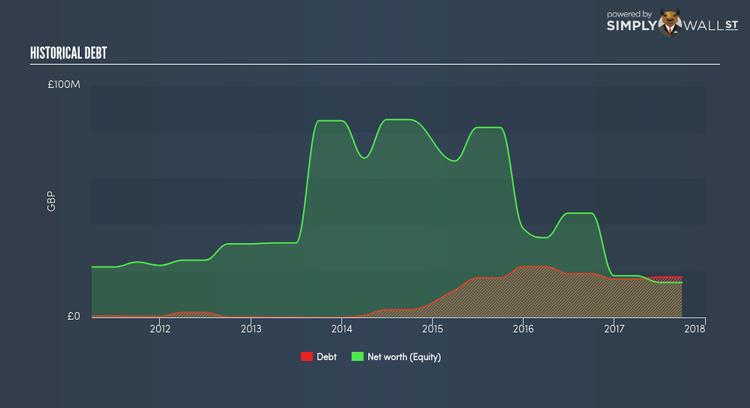What does The Stanley Gibbons Group plc’s (LON:SGI) Balance Sheet Tell Us Abouts Its Future?

Investors are always looking for growth in small-cap stocks like The Stanley Gibbons Group plc (AIM:SGI), with a market cap of £6.93M. However, an important fact which most ignore is: how financially healthy is the business? Specialty Retail businesses operating in the environment facing headwinds from current disruption, especially ones that are currently loss-making, tend to be high risk. So, understanding the company’s financial health becomes vital. Here are few basic financial health checks you should consider before taking the plunge. However, I know these factors are very high-level, so I suggest you dig deeper yourself into SGI here.
Does SGI generate an acceptable amount of cash through operations?
SGI has shrunken its total debt levels in the last twelve months, from £21.9M to £16.5M made up of predominantly near term debt. With this reduction in debt, SGI’s cash and short-term investments stands at £2.3M for investing into the business. Though its small level of operating cash flow means calculating cash-to-debt wouldn’t be too useful, though these low levels of cash means that operational efficiency is worth a look. For this article’s sake, I won’t be looking at this today, but you can examine some of SGI’s operating efficiency ratios such as ROA here.
Can SGI pay its short-term liabilities?
Looking at SGI’s most recent £45.8M liabilities, it appears that the company has been able to meet these commitments with a current assets level of £61.6M, leading to a 1.35x current account ratio. Usually, for specialty retail companies, this is a suitable ratio since there’s sufficient cash cushion without leaving too much capital idle or in low-earning investments.
Can SGI service its debt comfortably?
With total debt exceeding equities, SGI is considered a highly levered company. This is not uncommon for a small-cap company given that debt tends to be lower-cost and at times, more accessible. However, since SGI is currently unprofitable, there’s a question of sustainability of its current operations. Running high debt, while not yet making money, can be risky in unexpected downturns as liquidity may dry up, making it hard to operate.
Next Steps:
Are you a shareholder? SGI’s cash flow coverage indicates it could improve its operating efficiency in order to meet demand for debt repayments should unforeseen events arise. However, its high liquidity ensures the company will continue to operate smoothly should unfavourable circumstances arise. Given that SGI’s financial situation may change. I suggest keeping on top of market expectations for SGI’s future growth on our free analysis platform.
Are you a potential investor? SGI’s high debt levels is not met with high cash flow coverage. This leaves room for improvement in terms of debt management and operational efficiency. Though, the company will be able to pay all of its upcoming liabilities from its current short-term assets. I encourage you to continue your research by taking a look at SGI’s past performance analysis on our free platform to conclude on SGI’s financial health.
To help readers see pass the short term volatility of the financial market, we aim to bring you a long-term focused research analysis purely driven by fundamental data. Note that our analysis does not factor in the latest price sensitive company announcements.
The author is an independent contributor and at the time of publication had no position in the stocks mentioned.

